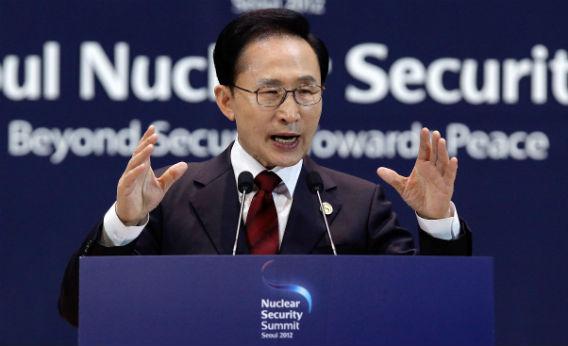In its latest taunts directed at South Korea, North Korea’s state-run media has called South Korean President Lee Myung-bak “human scum” and an “underwit with 2MB of knowledge.” How many megabytes should a human brain be able to store?
A lot more than two. Most computational neuroscientists tend to estimate human storage capacity somewhere between 10 terabytes and 100 terabytes, though the full spectrum of guesses ranges from 1 terabyte to 2.5 petabytes. (One terabyte is equal to about 1,000 gigabytes or about 1 million megabytes; a petabyte is about 1,000 terabytes.)
The math behind these estimates is fairly simple. The human brain contains roughly 100 billion neurons. Each of these neurons seems capable of making around 1,000 connections, representing about 1,000 potential synapses, which largely do the work of data storage. Multiply each of these 100 billion neurons by the approximately 1,000 connections it can make, and you get 100 trillion data points, or about 100 terabytes of information.
Neuroscientists are quick to admit that these calculations are very simplistic. First, this math assumes that each synapse stores about 1 byte of information, but this estimate may be too high or too low. Neuroscientists aren’t sure how many synapses transmit at just one strength versus at many different strengths. A synapse that transmits at only one strength can convey only one bit of information—“on” or “off,” 1 or 0. On the other hand, a synapse that can transmit at many different strengths can store several bits. Secondly, individual synapses aren’t completely independent. Sometimes it may take several synapses to convey just one piece of information. Depending on how often this is the case, the 10-to-100-terabytes estimate may be much too large. Other problems include the fact that some synapses seem to be used for processing, not storage (suggesting that the estimate may be too high), and the fact that there are support cells that might also store information (suggesting that the estimate may be too low).
Even if we accept that the storage capacity of the brain is between 10 and 100 terabytes, estimating how much of that space is “used space” versus “free space” is very difficult—the brain is simply much more complex than an external hard drive. Not only do some parts seem to be involved in many different memories at once, but this stored data is often being corrupted and even lost. One thing is certain: The notion that humans only use 10 percent of their brain is a myth—information may be stored in every part of the brain.
So how many megahertz does the brain run at? It may be best to say that the brain is a much more powerful machine made up of much slower processors. Each neuron seems to have a “clock speed” on the order of kilohertz, which are a million times slower than gigahertz. (A smartphone’s processor speed is around 1 gigahertz.) For this reason, computers are often much faster at completing specialized tasks, even though they can’t replicate all the varied functions of the human brain.
While futurists like Ray Kurzweil cite Moore’s law—the tendency of computers to become twice as powerful about every two years—to predict that we will be able to build computers more powerful than the human brain within the next two decades, it’s not clear that such a computer could be marketable. The brain is remarkably energy-efficient, running on about 12 watts—the electricity it takes to light some high-efficiency light bulbs. It would require so much energy to run a computer as powerful as the human brain—perhaps as much as “a gigawatt of power, the amount currently consumed by all of Washington, D.C.” —that it may be impractical.
Got a question about today’s news? Ask the Explainer.
Explainer thanks David Touretzky of Carnegie Mellon University, Nathan Urban of Carnegie Mellon University, and Samuel Wang of Princeton University.
